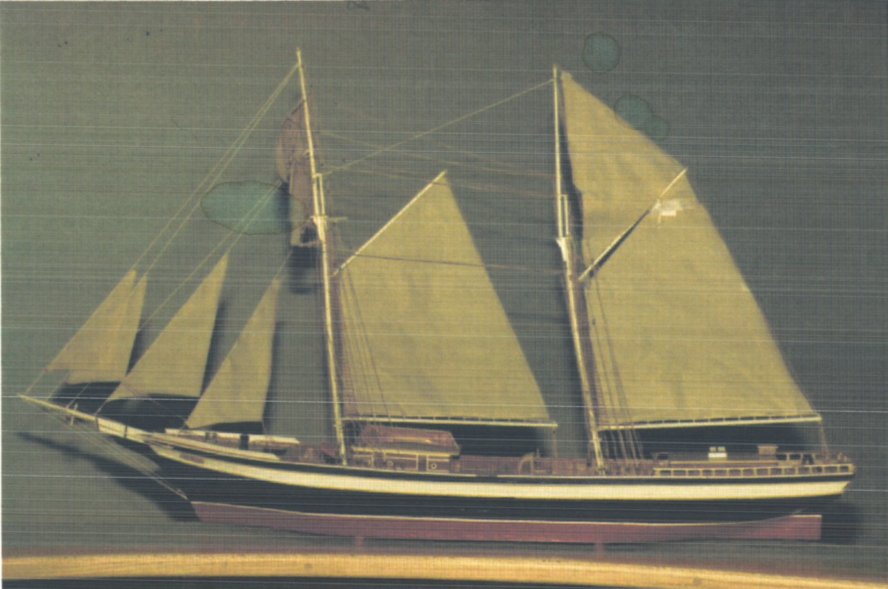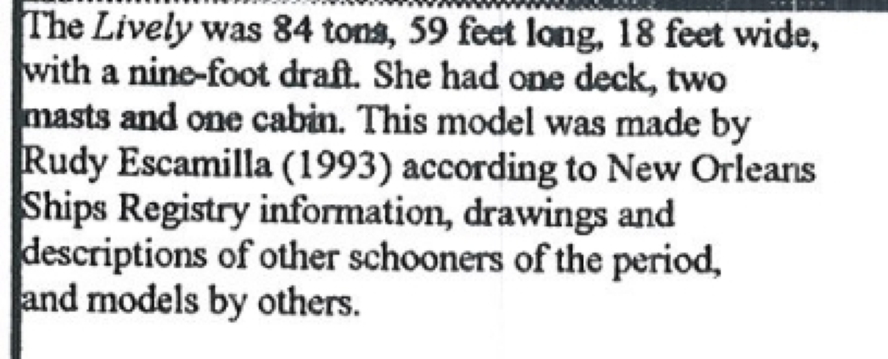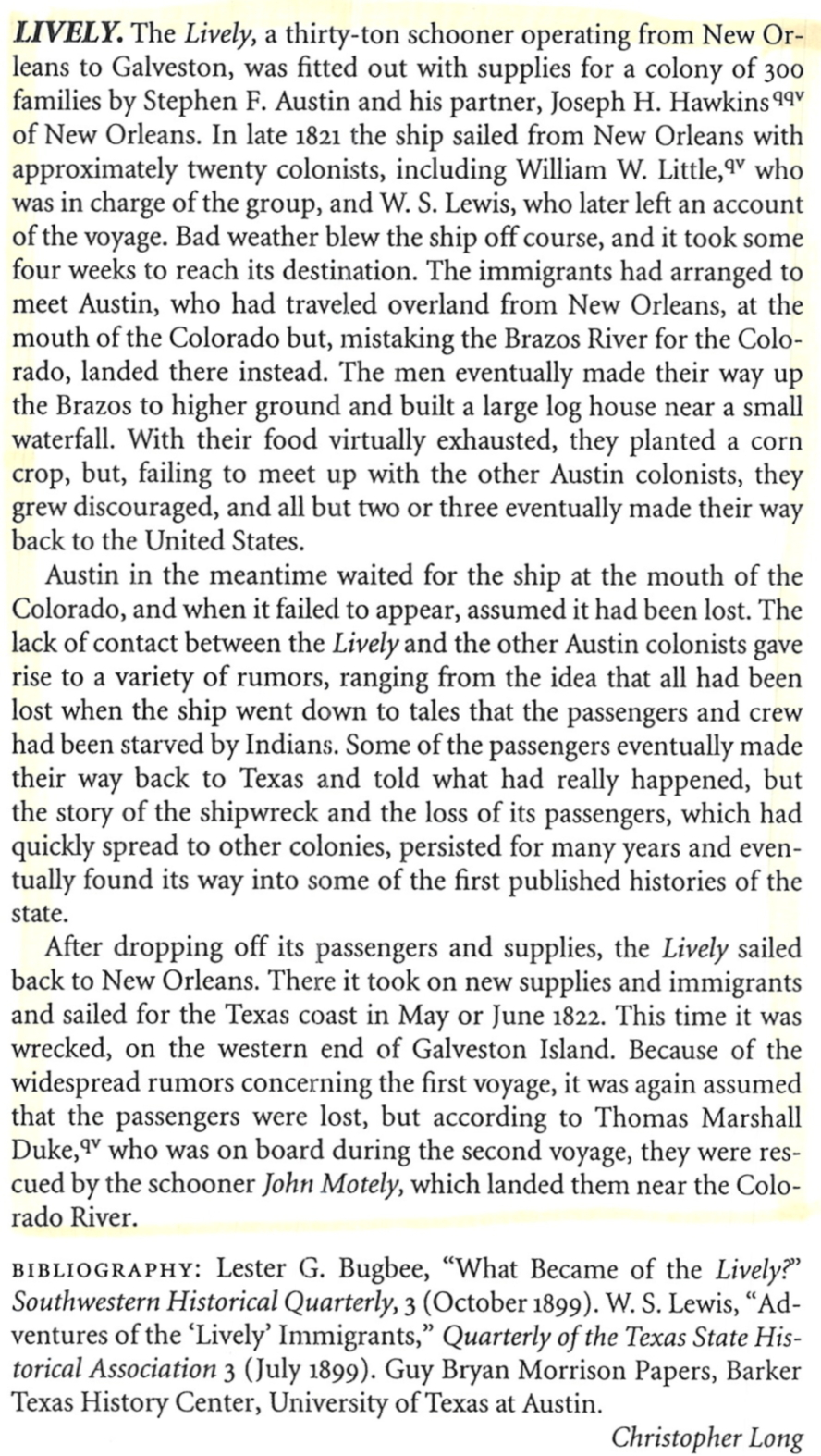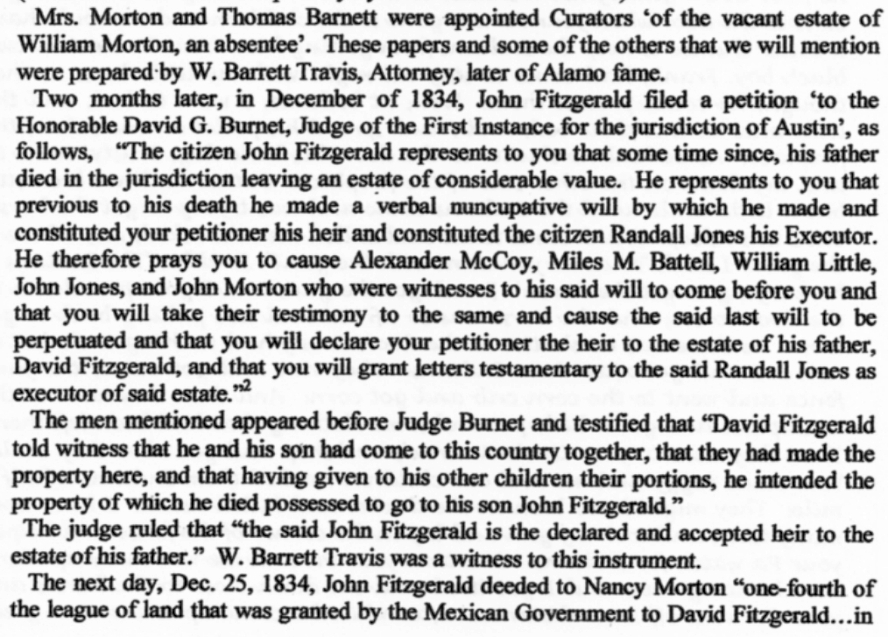
"Lively" Schooner
and her passengers




The Strange Odyssey of the Good Ship Lively PDF
Lively Schooner was missing for 4 weeks, here is why.
THE ADVENTURES OF THE "LIVELY" IMMIGRANTS, Part 1
THE ADVENTURES OF THE "LIVELY" IMMIGRANTS, Part 2
WILLIAM P. MORTON’S
ARRIVAL TO THE NEW AUSTIN’S COLONY
WITH CORRECTIONS AND EXPLANATIONS TO FOLLOW.
William Morton, one of Stephen F. Austin’s Old Three Hundred colonists, sailed from Mobile, Alabama with his wife and five children in 1822. After their schooner was wrecked on Galveston Island, Morton and his son, John V. Morton, encountered some passengers from the Lively schooner who helped the family build a yawl to get to the mouth of the Brazos. They went up the river to the bend, where they planted a crop in the fall of 1822. Morton voted in the colony election in April, 1824 and, as one of the Old Three Hundred, received title to 1 1⁄2 leagues and one labor (177 acres) of land in what is now Fort Bend County on July 15, 1824. He built his house on the east bank of the Brazos on his land, which extended to Oyster Creek. The census of March 1826 listed Morton as a farmer and stock raiser, aged between forty and fifty. His household then included his wife Jane, three sons, two daughters, one servant, and two slaves. Austin recommended Morton as a regidor (city council member) in January 1828. On May 4, 1829, the ayuntamiento (town council) appointed him to a committee to work out plans for an academy at San Felipe. He was granted a lot at San Felipe in February 1830 on condition that he build a brickyard on the land and the same February session of the ayuntamiento appointed him to help choose the route for a road from his home to Harrisburg. In September 1830 he was appointed to the committee to superintend the building of the jail at San Felipe. Morton was drowned in a Brazos flood in 1833. Randal Jones was the last person to see him alive. Daniel Perry was administrator of the Morton estate.
CORRECTIONS AND EXPLANATIONS
By John Walker
Earlier than the arrival of William Morton, the schooner “LIVELY “ arrived at the mouth of the Brazos River just in time for Christmas in 1821. The superintendant of cargo on the “LIVELY “ was William Little. There were several colonists on board also. The original plan was to meet Stephen F. Austin at the mouth of the Colorado River where it emptied into the Gulf of Mexico. This plan was flawed. The Colorado River did not [does not] empty into the Gulf of Mexico. It empties into Matagorda Bay some 40 miles from Pass Cavello where Matagorda Bay empties into the Gulf of Mexico. The “LIVELY “ mistook the mouth of the Brazos River for the mouth of the Colorado River. After waiting for a day or so for the presence of Stephen F. Austin, the “LIVELY “ unloaded its passengers and their cargo and sailed away.
In February a pair of strangers named David Fitzgerald and his son John arrived in a small boat with intentions to settle upriver. [John Fitzgerald’s sister would later arrive in the Colony under her married name of Fenn]. William Little and David Fitzgerald came up the Brazos River together along with other passengers from the LIVELY. William Little built his house on the east bank of the Brazos River [now Riverside subdivision] and David Fitzgerald also settled on the east bank of the Brazos River [near Hwy 90A].
Approximately three months after arriving at the location of his new residence, William Little organized an expedition to return to the mouth of the Brazos River. The purpose of this 1822 expedition was for the sole benefit of William Little. [To be explained in a moment.]
After their schooner was wrecked on Galveston Island, Morton and his son, John V. Morton, encountered some passengers from the Lively who helped the family build a yawl to get to the mouth of the Brazos. Exactly where did they wreck? The closest point on Galveston Island to the mouth of the Brazos River is San Louis Pass. The passengers from the “LIVELY “ had departed upriver two months earlier. William and John Morton encountered an expedition sent by William Little to welcome William P. Morton and his family. Most important to William Little was William Morton’s stepdaughter, Jane Edwards Little, William Little’s wife.
William Morton, one of Stephen F. Austin’s Old Three Hundred colonists, sailed from Mobile, Alabama with his wife and five children in 1822. The census of March 1826 listed Morton as a farmer and stock raiser, aged between forty and fifty. His household then included his wife Jane, three sons, two daughters, one servant, and two slaves. William Morton’s oldest son was John V. and his only other son, William P. Morton Jr., was a babe in arms when they wrecked. [After his father disappeared he was able to drop the Jr.] His name would appear in history as being the same as his father’s His oldest daughter was Lousia Ann [AKA Lousianna] and his only other daughter was Mary. William Morton only had 4 children. His wife was named Nancy, not Jane. There never was a Jane Morton as she did not exist.
I want to explain the purpose of the William Little expedition as I promised above.
The year was 1781. The place is Missouri. The event is the birth of a baby girl to her Pettigrew parents. They named her NANCY. When Nancy Pettigrew grew up, she married Mr. Edwards and they had a daughter they named JANE. For whatever the reason Nancy Pettigrew Edwards was again single and she married William P. Morton of Mobile. Jane Edwards married William W. Little, in Missouri, early in 1821.In the United States, in November 1821, William Little contracted with Austin to work for him in Texas until December 1822 building cabins, a stockade and planting five acres of corn. He sailed as superintendent of cargo on the “LIVELY “ and reached the mouth of the Brazos River on Christmas in 1821. The “LIVELY “ then left them stranded and headed for Port San Bernardo. One day a party in a 40 foot PRIGUE came into the mouth of the Brazos River with David Fitzgerald and his son John. In February 1822 the party moved upstream until William Little and David Fitzgerald both camped at the great bend of the Brazos.[-RICHMOND-] David Fitzgerald immediately started building his house on land he wished to own on the EAST SIDE of the Brazos..
In the middle of March, it was decided, by William Little, to send a group to visit the mouth of the Brazos in hopes of finding more colonists. There were none found so they spent a few days fishing. After a few days a SMALL YAWL [rowboat] reached the river bringing William Morton and his 17 year old son John. The Morton group had shipwrecked a sailboat and needed help to rescue the mother and [5 daughters]. You already know this is not accurate].
This was not just a fishing trip. This trip to the coast at the mouth of the Brazos River would have been caused by Jane Edwards Little. She was with the Morton group and her husband wanted someone to meet his wife's arrival to the Brazos.
=========================================
This makes Jane Edwards Little a half sister to the children of Nancy and William Morton.
The expedition was to meet and welcome William Little’s wife to Austin’s Colony. Jane was Nancy’s daughter by a previous marriage and a step daughter to William Morton.
Morton voted in the colony election in April, 1824 and, as one of the Old Three Hundred, received title to 1 1⁄2 leagues and one labor (177 acres) of land in what is now Fort Bend County on July 15, 1824. He built his house on the east bank of the Brazos on his land, which extended to Oyster Creek.
The labor of land was on the west bank of the Brazos. The first house William Morton built was on this labor of land. The Morton Cemetery is on this labor of land close to Morton’s first house. Later he built a second house on the east bank. There was five of the early colonist that was determined to be ‘undesirable’. Among other crimes, owing debts would be a consideration for being ‘undersiable’. The only ‘undersiable’ to stay in Austin’s Colony was David Fitzgerald. When Fitzgerald applied for land he had built his house on, he was told the property was already granted to William Morton. William Morton received the first land grant in Austin’s Colony, a labor of land on the west side of the Brazos River, where he lived, and 1 1/2 leagues on the east side of the river opposite his labor of land. This property happened to include the dwelling of the ‘undersirable’ David Fitzgerald and his son John.To solve the crisis Morton agreed to trade one fourth of his league for one fourth of Fitzgerald’s league when Fitzgerald was awarded his own land. Having to go through the Mexican government for processing, the official trade was postponed. David Fitzgerald attended the battle of Anahuac and died shortly after returning in 1832. William Morton ‘vanished’ in a flooded Brazos River in 1833. Both parties of the agreement were now not available.
The timeline beginning with the these settlers arriving at the mouth of the Brazos River in 1821.
1821 plus 11 years after their arrival at the mouth of the Brazos to1832.
David Fitzgerald and his son John arrived in December of 1821 at the mouth of the Brazos in their own boat, but not on the Lively. They came up the river with the boats carrying the Lively passengers. David and John settled on the east bank of the river [near what is now Hwy 90A] and built their house. Shortly after arriving, five settlers were declaired 'undesirable' by Steven F. Austin incuding David Fitzgerald. Four of the 'undesirables' returned to the United States, but not the Fitzgeralds.
The history of the arrival of the Morton family is above.
1824 Was the year the first land grant was awarded. William Mortom received a Labor on the west side of the Brazos and a League and a half on the east side, directly across the river from the Labor of land. This League and a half included the Fitzgerald's occupied property. Willliam Morton and David Fitzgerald agreed to trade 1/4 of each others League.
1832 David Fitzgerald attended 'The Battle of Anahuac' and shortley after returning, he died. His son John was the next of kin to bury David. John had limited choices for the grave location. He did not own property where they lived and would have had to get permission from Mr. Morton to bury his dad on the property, or he could have buried his dad on the Fitzgerald League they owned. It is my belief he buried his dad on the east side of Long Point Creek in the Fitzgerald League. This would become the start of the Duke/Fenn Cemetery.
1833 was the year William Morton entered the swollen Brazos River and vanished.
1834 was the year that John Fitzgerald Partitioned the court
.
1835 was the year Daniel Perry married Lousianna Morton for his second wife. They began living on the newly traded 1/4 of the Fitzgerald League. This area would soon be known as Duke, Texas [also as Clear Lake, Texas]Lousianna Morton Perry came to Texas in 1822 by the mouth of the Brazos River. She is Buried in the Duke/Fenn Cemetery
1836 was the Runaway Scrape. Santa Anna crossed the Brazos at Richmond, burned Nancy, John V., Mary and Wm P. Jr. Morton's residence and also burned the Fitzgerald's residence. After they discover the ashes of their homes the Mortons stayed with Daniel and Lousianna Perry while John Fitzgerald and his sister Sarah Fitzgerald Fenn, her husband Eli and youngster John Rutherford stayed with Moses Shipman and his family. Nancy Morton and John V. Morton are buried in the Duke/Fenn Cemetery.
This is the last that Fort Bend County's official history mentions the location of the Mortons or Fitzgeralds.
You can read about their life after the Battle of San Jacinto by clicking here.
This is the most accurate account of
David Fitzgerald and Fenn Family PDF